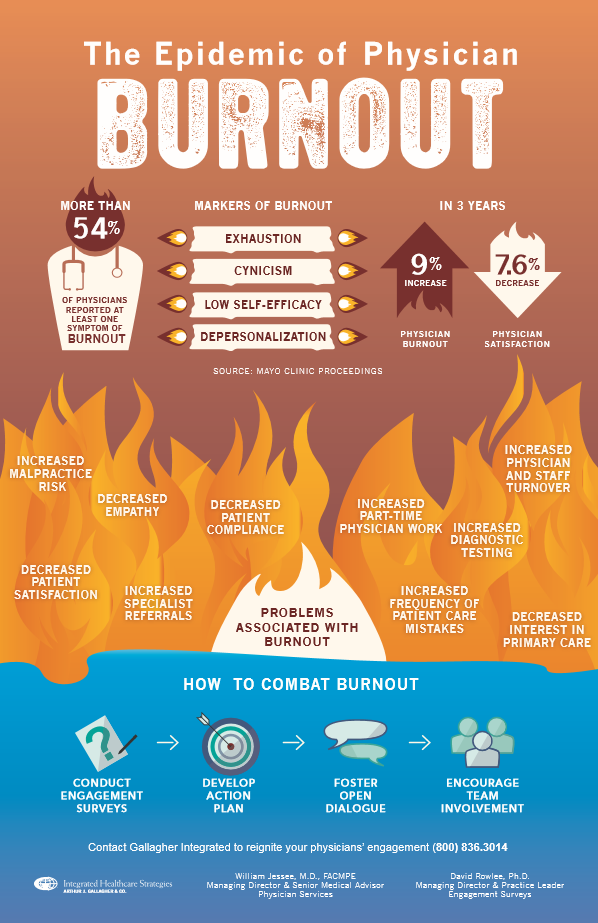The evidence is rapidly accumulating to suggest that physician burnout has reached epidemic levels in the US healthcare delivery system.
In a December 2015 article from the Mayo Clinic Proceedings, researchers reported that 54.4 percent of physicians responding to a large national survey reported at least one symptom of burnout. In an identical survey in 2011, the burnout rate was 45.5 percent—representing a rise of almost 9 percent in only three years1. Of equal concern, they found that physicians' satisfaction with their work–life balance had declined from 48.5 percent in 2011 to 40.9 percent in 2014. In contrast with the high rate of burnout among physicians, only 28 percent of working adults in the general population show symptoms of burnout, and that rate has remained stable over the last several years.
What is burnout?
Social psychologist Christina Maslach, PhD, has studied burnout extensively. In fact, the most widely used survey instrument for assessing burnout is the Maslach Burnout Inventory. According to Dr. Maslach, four key factors are now regarded as the most prominent markers of burnout:
- Exhaustion: physical and emotional tiring
- Cynicism: negativity about the organization and its leaders
- Low self-efficacy: loss of ability to control one's work
- Depersonalization: disconnecting from both people and the organization
Physicians who show signs of burnout also are unlikely to be engaged with their organization. In fact, one could postulate that "burnout" is the inverse of "engagement." One useful description of physician burnout is a state of disinterest characterized by opposition, misery and disloyalty, which fosters a broken relationship between physicians and organizations creating career harm and non-achievement of organizational goals. Contrast that with the definition of "engagement" which we use at Gallagher Integrated. "Engagement is a state of enthusiasm characterized by belonging, pride and loyalty, which fosters a mutually committed relationship between physicians and organizations resulting in the enduring pursuit of career enrichment and organizational goals."
Why burnout is a concern
There is rich literature demonstrating the adverse consequences of physician burnout for patients, organizations and the physicians themselves. Among the problems associated with burnout are:
- Increased frequency of patient care mistakes
- Decreased patient adherence with treatment recommendations
- Decreased empathy
- Decreased patient satisfaction
- Increased malpractice risk
- Increased part-time physician work
- Increased physician AND staff turnover (with attendant costs)
- Increased diagnostic testing
- Increased specialist referrals
- Decreased interest in primary care
Clearly, the stakes are high if physician burnout is not aggressively confronted by hospitals and medical groups around the country.
What can you do to combat burnout and increase engagement?
As with many of the challenges facing healthcare executives and leaders today, the best place to start is with a diagnostic evaluation of your organization. One of Gallagher Integrated's busiest practices is our Engagement Survey practice, which has measured both employee and physician engagement in hundreds of organizations around the country. A physician engagement survey can give you not only baseline data about the level of engagement among your physicians, but also important information by specialty, service line or other demographic variables. That information can then be used to formulate an action plan that is specific to the groups showing the lowest levels of engagement — and thus, create the greatest opportunity for improvement.
Unengaged physicians often feel that they are powerless to change the way care is delivered in their organization. One of the first steps to enhancing their engagement is to aggressively open up a variety of communication channels, and to provide multiple opportunities for physicians to have a voice in everything from strategic planning, to operational improvement. As noted earlier, burnout manifests itself as a perception of powerlessness. The best way to counter that impression is by seeking means for involving physicians in key strategic and operational decision-making, helping them to realize they have choices and opportunities for greater control over their work, and building the spirit of camaraderie and teamwork that produces organizational excellence.
Of perhaps equal importance is the development of strong physician leadership, through organized leadership development curricula. As with other workers, physicians who feel that their leaders are not collaborative, collegial and competent are much more likely to manifest signs of burnout than are others2.
If you would like either to pursue a diagnostic evaluation of physician engagement in your organization, or assistance in enhancing engagement and combating burnout, contact either:
William F. Jessee, MD, FACMPE
Bill.jessee@ihstrategies.com
612-339-0919
David D. Rowlee, Ph.D
David.Rowlee@ihstrategies.com
816-795-1947
References
1. Shanafelt, T.D., Hasan, O., Dyrbye, L.N. et al. Changes in burnout and satisfaction with work-life balance in physicians and among the general US working population between 2011 and 2014. Mayo Clinic Proceedings, (90:1600-1613), December, 2015.
2. Swensen, S., Kabcenell, A. and Shanafelt, T. Physician-organization collaboration reduces physician burnout and promotes engagement: the Mayo Clinic experience. J. Healthcare Mgt., (61:105-128), March-April, 2016.



